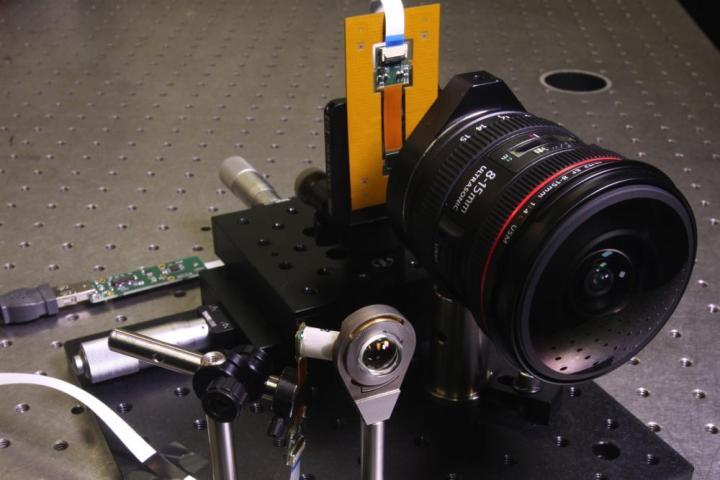
While camera makers have now conceded the traditional point-and-shoot market to smartphones, they have taken solace in the fact that they still rule the more advanced spectrum of the market, with cameras like interchangeable lens DSLRs and compact system models. Well, not if smartphone technology continues to accelerate, like this new ultra-wide-angle lens developed by the University of California, San Diego.
As Pop Photo reports, the lens, created by researchers at UCSD’s Jacobs School of Engineering, is small enough to fit inside a smartphone yet has the optical performance to rival traditional DSLR lenses. “The new imager achieves the optical performance of a full-size wide-angle lens in a device less than one-10th of the volume of a regular lens,” according to the researchers. When you consider the size difference between a DSLR lens glass to components in a smartphone, that’s a huge achievement.

Part of a newly developed camera system made in collaboration with DARPA for the Soldier-Centric Imaging with Computational Cameras (SCENICC) program, this wide-angle lens has a 12mm focal length connected to a 5-megapixel image sensor, and uses a “fiber-coupled” monocentric lens made from concentric glass shells, which are perfectly round like glass marbles, the researchers said. The symmetry from this design allows the lens to produce high-resolution wide-angle images without the geometrical distortions of typical fisheye lenses. Unlike previously developed monocentric lenses, the UCSD researchers said theirs can better convey the rich information collected by the lens to the sensors via an optical fiber connection, and the optical fibers allow for improved focusing. While the camera is designed with aerial drones in mind, it could also be implemented in smartphones.
“It can image anything between half a meter and 500 meters away – a 1,000x range of focus – and boasts the equivalent of 20/10 human vision – 0.2-milliradian resolution,” the researchers said. “Such a system could enable high-resolution imaging in micro-unmanned aerial vehicles, or smartphone photos more comparable to those from a full size SLR camera.”

“The major commercial application may be compact wide-angle imagers with so much resolution that they’ll provide wide-field pan and ‘zoom’ imaging with no moving parts,” project leader Joseph Ford said. He and his team will present the tech at the Optical Society’s annual meeting in Orlando, Florida next week. At the conference, Ford will also talk about the continued development of the technology. The researchers are currently building a version with a 30-megapixel sensor, and, “next year, we’ll build an 85-megapixel imager with a 120-degree field of view, more than a dozen sensors, and an f/2 lens – all in a volume roughly the size of a walnut.”
The lens’ capability still depends on the strength of the sensor, but image samples show that the monocentric lens can deliver great clarity even without the fiber coupling. A sample image produced by the prototype system is visibly clearer than the once produced by a Canon EOS 5D Mark III with a 12mm focal length and identical 5-megapixel focal planes. While we won’t see this technology in consumer products right away, it’s clearly another indication that miniature cameras are improving.
(Images via Jacobs School of Engineering/University of California, San Diego)


